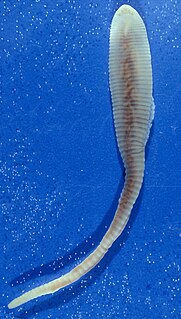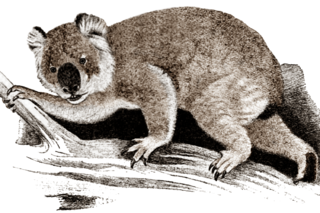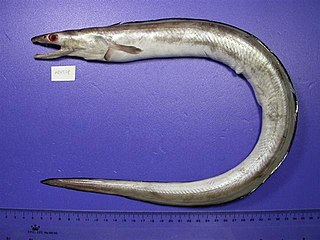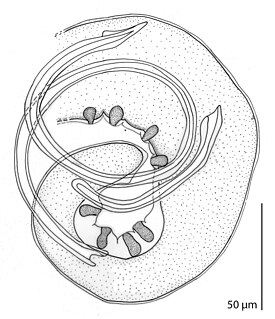Related Research Articles

The koala or, inaccurately, koala bear, is an arboreal herbivorous marsupial native to Australia. It is the only extant representative of the family Phascolarctidae and its closest living relatives are the wombats, which are members of the family Vombatidae. The koala is found in coastal areas of the mainland's eastern and southern regions, inhabiting Queensland, New South Wales, Victoria, and South Australia. It is easily recognisable by its stout, tailless body and large head with round, fluffy ears and large, spoon-shaped nose. The koala has a body length of 60–85 cm (24–33 in) and weighs 4–15 kg (9–33 lb). Fur colour ranges from silver grey to chocolate brown. Koalas from the northern populations are typically smaller and lighter in colour than their counterparts further south. These populations possibly are separate subspecies, but this is disputed.

The Phascolarctidae is a family of marsupials of the order Diprotodontia, consisting of only one extant species, the koala, and six well-known fossil species, with another five less well known fossil species, and two fossil species of the genus Koobor, whose taxonomy is debatable but are placed in this group. The closest relatives of the Phascolarctidae are the wombats, which comprise the family Vombatidae.

Phascolarctos is a genus of marsupials containing only one extant species, the koala (P. cinereus). The genus was named by French zoologist Henri Marie Ducrotay de Blainville in 1816.

The Pentastomida are an enigmatic group of parasitic arthropods commonly known as tongue worms due to the resemblance of the species of the genus Linguatula to a vertebrate tongue. They are traditionally seen as crustaceans, even if that position has been questioned.

The giant koala is an extinct arboreal marsupial which existed in Cascade Australia during the Pleistocene epoch. Phascolarctos stirtoni was about one third larger than the contemporary koala, P. cinereus, and has had an estimated weight of 13 kg (29 lb), which is the same weight as a large contemporary male koala. Although considered a part of the Australian megafauna, its body mass excludes it from most formal definitions of megafauna. It is better described as a more robust koala, rather than a "giant"; in contrast, a number of Australian megafauna, such as Diprotodon and Procoptodon goliah, were unambiguously giants. The two koala species co-existed during the Pleistocene, occupying the same arboreal niche. The reason for the extinction of the larger of the two about 50,000 years ago is unknown, although there are various hypotheses for the extinction.

The daggertooth pike conger is a species of eel in the pike conger family, Muraenesocidae. They primarily live on soft bottoms in marine and brackish waters down to a depth of 800 m (2,600 ft), but may enter freshwater. They are common to about 1.5 m (4.9 ft) in length, but may grow as long as 2.2 m (7.2 ft). Daggertooth pike congers occur in the Red Sea, on the coast of the northern Indian Ocean, and in the West Pacific from Indochina to Japan. It has also invaded the Mediterranean through the Suez Canal.
Chlamydia pecorum, also known as Chlamydophila pecorum is a species of Chlamydiaceae that originated from ruminants, such as cattle, sheep and goats. It has also infected koalas and swine. C. pecorum strains are serologically and pathogenically diverse.

Gongylonema is a genus of thread-like nematode that was described by Molin in 1857. It is the only currently valid genus in the family Gongylonematidae, though the mysterious Spiruroides – usually placed in the Subuluridae, which are not closely related to Gongylonema among the Spiruria – might actually belong here. They are parasites of birds and mammals, transmitted by insects. Some 38 species are known, about 12 of which have been recorded in Europe.

Illiosentidae is a family of parasitic worms from the order Echinorhynchida.
Trypanosoma irwini is a blood parasite of koalas. First discovered in 2009 by Linda M. McInnes and her peers, it was named in honor of Steve Irwin, "The Crocodile Hunter". The study done by McInnes et al. was the first to describe a Trypanosoma species from koalas.

Huffmanela is a genus of parasitic nematodes, belonging to the family Trichosomoididae.

The Trichosomoididae is a family of nematodes.
Sporobolomyces koalae is a species of fungus in the order Sporidiobolales. It is an anamorphic yeast. Strains of the yeast were isolated from nasal swabs from three of five captive Queensland koalas kept at the Kobe Oji Zoo in Kobe, Japan. Swabs from three zoo keepers were examined as well, but tested negative for the presence of the yeast. It is not suspected to be pathogenic, as the koalas from which it was isolated were healthy.

Huffmanela hamo is a parasitic nematode. It has been observed in the muscles of the dagger-tooth pike conger Muraenesox cinereus, a muraenesocid marine fish off Japan. Its life-cycle is unknown.

Odilia is a genus of nematode worms established by Marie-Claude Durette-Desset in 1973 that infect mostly murid rodents of the Australasian region (species of Melomys, Rattus and Uromys from mainland Australia and Tasmania.

Cucullanus is a genus of parasitic nematodes. The genus includes more than 100 species.

Physalopteridae is a family of spirurian nematodes, which belongs to the superfamily Physalopteroidea. Like all nematodes, they have neither a circulatory nor a respiratory system.

František Moravec is a Czech parasitologist who specialised on the Nematodes, especially the nematodes parasites of fishes. His research was mainly in the field of taxonomy of the Nematoda.

Cystidicolidae is a family of spirurian nematodes. It was created by Skrjabin in 1946. All members of the family are parasites of fish.
References
- ↑ Anderson RC, Chabaud AG, Willmott S (2009). Keys to the Nematode Parasites of Vertebrates: Archival Volume. CABI. p. 27. ISBN 978-1-84593-572-6.
- ↑ Spratt, D. M.; Speare, R. (1982). "Durikainema macropi gen. et sp. nov. (Muspiceoidea : Robertdollfusidae), A remarkable nematode from Macropodidae (Marsupialia)" (PDF). Annales de Parasitologie Humaine et Comparée. 57 (1): 53–62. doi: 10.1051/parasite/1982571053 . ISSN 0003-4150.

- ↑ Spratt DM, Gill PA (1998). "Durikainema phascolarcti n. sp. (Nematoda: Muspiceoidea: Robertdollfusidae) from the pulmonary arteries of the koala Phascolarctos cinereus with associated pathological changes". Systematic Parasitology. 39: 101–6. doi:10.1023/A:1005957809179.